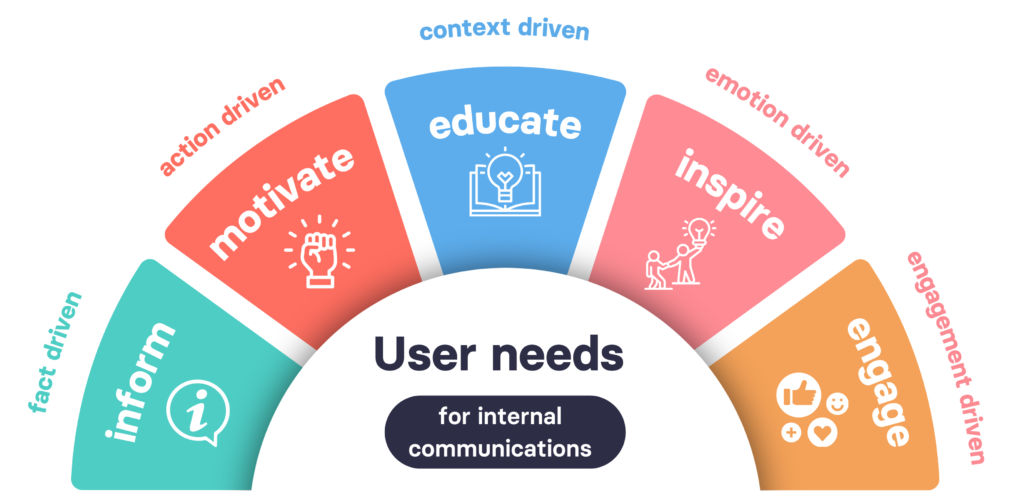How often do employees feel overwhelmed by company emails? Or worse, completely disconnected from leadership?
Most internal communications feel like noise. Emails get ignored, important updates go unnoticed and employees feel left out of key conversations.
Internal communications can no longer rely on one-way messaging. Employees don’t just need information; they need context, motivation, inspiration and engagement to feel connected to their work and organization.
That’s where the User Needs Model for Internal Communications comes in. This whitepaper introduces a structured framework that ensures messages are purposeful, engaging and effective, transforming how organizations communicate with their employees.
The origin of the User Needs Model
The User Needs Model was first developed for journalism by Dmitry Shishkin at the BBC World Service in 2017. It helped newsrooms move away from generic reporting and instead create content tailored to distinct audience needs.
By structuring news into categories like “Update Me,” “Educate Me” and “Inspire Me,” this approach revolutionized digital storytelling, increasing engagement and impact.
Later, Smartocto collaborated with Shishkin to refine the model further, incorporating data-driven insights to help newsrooms measure and optimize their content strategies.
The result was User Needs Model 2.0, an industry-leading framework used by global media organizations to enhance storytelling and audience engagement.
Recognizing that employees are an audience too, we adapted this model for internal communications, addressing the challenges organizations face in keeping employees informed, engaged and aligned with company goals.
What is the User Needs Model for Internal Communications?
Originally designed for media, the User Needs Model has now been adapted to help organizations communicate more effectively with employees. Instead of a one-size-fits-all approach, this model ensures that every message aligns with what employees actually need.
The five core dimensions of the User Needs Model for Internal Communications are:

- Inform me (Fact-driven communication) – Ensures employees receive timely, clear and relevant updates.
- Motivate me (Action-driven communication) – Encourages employees to participate, engage and take action on company initiatives.
- Educate me (Context-driven communication) – Provides background and insights to help employees connect the dots and understand decisions.
- Inspire me (Emotion-driven communication) – Strengthens company culture through storytelling, recognition and purpose-driven messages.
- Engage me (Engagement-driven communication) – Facilitates two-way communication, ensuring employees feel heard and involved in company conversations.
This framework transforms internal communications from a one-way broadcast to a dynamic, two-way conversation.

Why this model matters
Many organizations struggle with internal communications because they rely on generic, one-size-fits-all messaging that fails to connect with employees.
The User Needs Model helps organizations:
- Enhance transparency by fostering two-way communication between leadership and employees.
- Reduce information overload by delivering content in a structured, intentional manner.
- Build stronger company culture by using storytelling and recognition to inspire employees.
By implementing this model, companies can create more engaging, purpose-driven internal communication strategies that drive better alignment and employee satisfaction.
What’s inside this whitepaper?
The User Needs Model for internal communications whitepaper is a comprehensive guide that provides actionable insights, including:
- A deep dive into the five core dimensions and how they apply to workplace communication.
- Best practices for structuring internal messages under each category.
- Real-world examples of organizations applying this model successfully.
- Implementation strategies using internal communication platform like tchop™.
- Measurement and analytics recommendations to track effectiveness and optimize communications.
This whitepaper is designed for internal communication professionals, HR leaders and business executives looking to build a more transparent, engaging and connected workplace.

How to implement the User Needs Model in your organisation
1. Audit your existing communications
Assess your current communication strategy. Are your messages clear, engaging and aligned with employee needs? Identify gaps where you can implement the five core dimensions.
2. Categorise content using the five dimensions
Map your communication efforts to Inform, Motivate, Educate, Inspire and Engage. This helps in structuring a balanced mix of updates, engagement-driven content and inspirational messages.
3. Use tools for automation and targeting
Platforms like tchop™ help automate message distribution, personalize content based on employee roles and track engagement analytics to refine communication strategies.
4. Foster two-way communication
Encourage employees to interact, give feedback and participate in discussions. Use surveys, Q&As, and town halls to ensure they feel heard and valued.
5. Measure and optimise
Use engagement metrics, open rates and feedback loops to refine your internal communications strategy. The whitepaper provides frameworks for analysing impact and improving content effectiveness.
Download the whitepaper and transform your internal communications
The User Needs Model for internal communications is a new way of thinking about workplace communication. By understanding and aligning with what employees truly need, organizations can foster greater engagement, trust and alignment.
If your internal communication strategy isn’t working, it’s time for a change. Download the whitepaper today and discover how the User Needs Model can transform your workplace.








